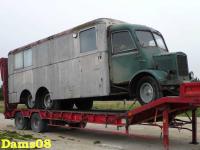ZIL » 135E
ZIL-135E was the first transition model from amphibious ZIL-135 to an extensive serial range with a radically new design. Two prototypes of ZIL-135E were made in April 1960. They were unified with amphibious prototypes ZIL-135, but instead of a flatbed body recieved an open frame, and the distance between axles increased to 2400 mm. The new chassis was also equipped with two power units ZIL-375YA, automatic on-board transmission, and frameless fiberglass cabin.
Development of ZIL-135E started in July 1959, after first prototypes ZIL-135 failed tests. ZIL-135E got a reinforced welded frame. The new prototypes had no any hull and water cannons, so the height of an open frame was about 1 m. ZIL 135E had no suspension. A 3-place cabin without a metal frame was made of fiberglass.
Compared to ZIL-135 the design of a transmission remains unchanged. The wheelbase was increased to 6300 mm (2400 + 1500 + 2400 mm), track of all wheels was increased to 2342 mm. Dimensions - 9270x2800x2530 mm, ground clearance under the frame - 580 mm, under axles - 475 mm. Turning radius - 12.5 m. Curb weight - 8.9 tonnes, GVW - 18 tonnes. Average fuel consumption - 134 liters per 100km.
In early September 1960, missle system SUP 2P21 (BR-226-II) 'Moon' was mounted on two prototypes of ZIL-135E. Tests carried out in March 1962. The vehicles quite easily crossed engineering obstacles, fording swamps with depth of 1.0 - 1.2 m. But the final conclusion was too categorical: ZIL-135E can not be recommended to military use. The main drawback was lack of a suspension, reduced speed and causes pitching, complexity of the twin-engine design, lack of reliability, maintenance labor intensity, increased to 920 kg weight, small capacity, high fuel consumption, and other. The factory began to develop a version with a suspension, called ZIL-135L.
















